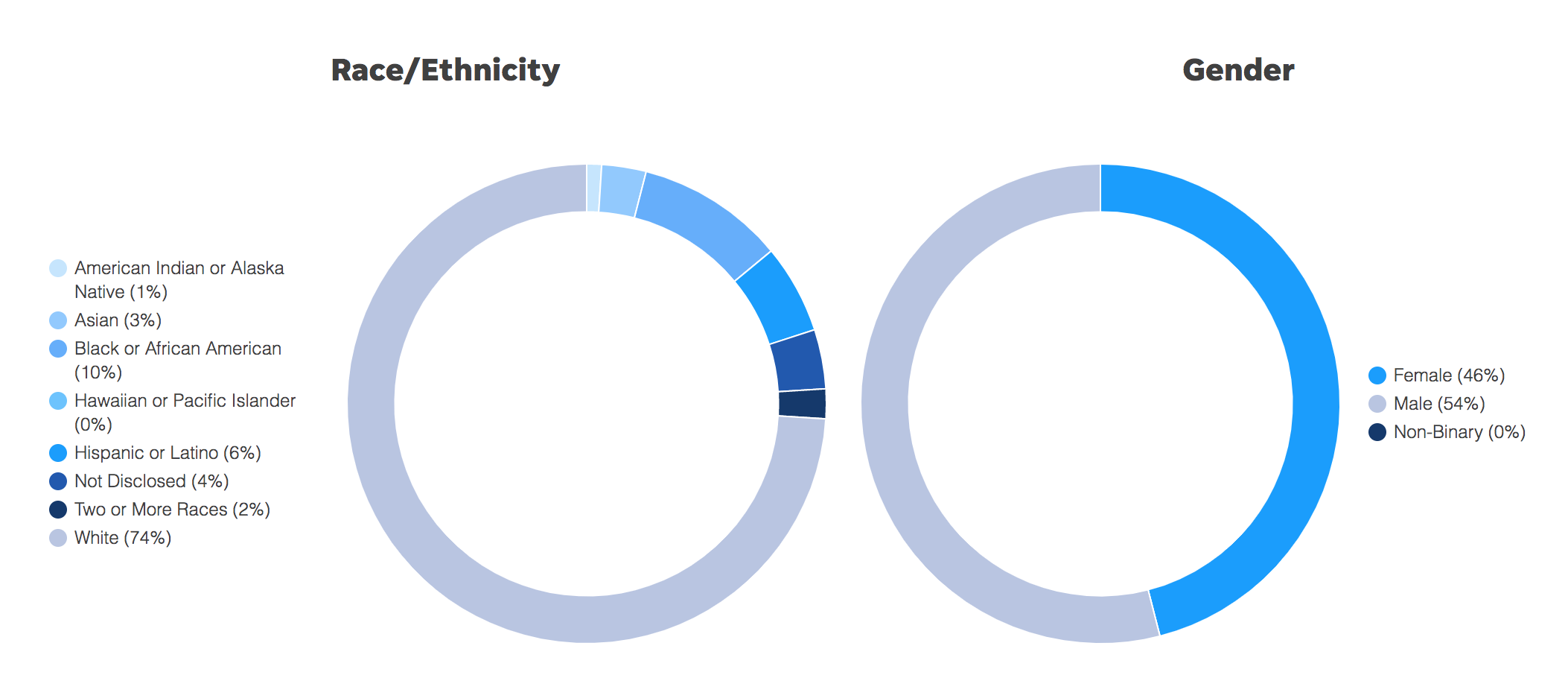
On Thursday, Gannett, the parent company of USA Today and more than 260 daily local news outlets in the United States, pledged its commitment to diversity, inclusion, and parity in all of its newsrooms.
On Wednesday, the company had published its workforce demographics, along with its intention to “make its workforce as diverse as the country by 2025 and to expand the number of journalists focused on covering issues related to race and identity, social justice and equality.” In the entire company, here’s how diversity breaks down:

Maribel Perez Wadsworth, president of news at Gannett Media and the publisher of USA Today, wrote on Thursday that newsrooms that aren’t representative of their communities can’t fully understand their needs and interests. From that column:
I want to acknowledge the gaps in these reported demographics. They do not completely represent our diversity nor do they quantify fully how far we must yet go to be truly representative. Specifically, these numbers fail to capture sexual orientation or gender identity. These statistics have not been previously incorporated into our human resource reporting or in the U.S. Census.
Gannett is committed to creating a culture where every employee feels safe, included and championed for their full identity. This week, the company announced important steps to expand our demographic data to be more inclusive by providing employees the opportunity to be heard and voluntarily self-identify as diverse in ways beyond race and ethnicity, such as identifying as LGBTQ.
In addition to setting this important parity goal, we are making significant investments in our coverage of race, equality and social justice.
By the end of the year, we will have created 20 national and 40 local jobs focused on social justice, disparities and inclusion to augment our coverage of race at the intersection of every critical institution, including education, health care, criminal justice and the environment. More than a third of this investment will come from incremental hiring, and the rest will result from a reprioritization of existing reporting and editing resources.
These new hires and jobs serve to underscore our commitment to diverse staffing and news coverage at USA TODAY and our local newsrooms. And it’s a commitment that starts at the top.
Many local newsrooms published one story with a graphic illustrating its census (some newsrooms made their charts embeddable but others did not) while others opted for a few paragraphs outlining their statistics. Executive editors separately published letters to readers about their commitment to improving their coverage and newsroom diversity.
Michael Kilian, the executive editor of the Rochester Democrat and Chronicle, included some interesting information in his column about what’s worked in his newsroom:
- We increased the percentage of our content of interest to diverse audiences from only 3% in the early fall of 2019 to as high as 25% earlier this summer.
- We cut in half the percentage of routine crime stories, while creating more content about communities’ responses to issues. Since February, we are producing more content of interest to diverse audiences than we are creating traditional crime content.
- Most important, we’ve begun getting substantial news tips from our new partners and contacts. Over time, such news tips help reporters point themselves in a direction toward creating relevant, authentically told stories.
Here’s a sampling of diversity reports from some Gannett newsrooms across the country:
The News-Press and the Naples Daily News:
Gannett has launched a Diversity Advisory Council, which will be led by CEO Michael Reed and director of inclusion, diversity and equity LaToya Johnson. Gannett’s new job postings also went live today:
At @USATODAY, we're adding jobs to our news, sports, investigations, entertainment, money, opinion and audience teams. Here are some of those new positions👇
— Gannett | USA TODAY NETWORK (@usatncareers) August 20, 2020
A full list that links to each newsroom’s census can be found at the end of Wadsworth’s column.
Maybe not this photo. pic.twitter.com/uiksZdgKLo
— Andrew Villegas (@ReporterAndrew) August 20, 2020
The Detroit Free Press released its diversity numbers.
Its staff (of 92) is 12% Black.
In total, it’s staff is 28% people of color.
Nearly 70% of the people who work for a newspaper reporting on a city that is 80% Black are White.
Let. That. Sink. https://t.co/TIkVr40OU9
— alex. (@Alex_Washington) August 20, 2020
Damn. Good on @DandC for recognizing this and *actually doing something about it* https://t.co/d5qkXKXd3z pic.twitter.com/3THhQWthIm
— Caitlin Dewey Rainwater (@caitlindewey) August 20, 2020
“As a Latina and the daughter of immigrants, it pains me that people of color are so often treated with indifference and contempt by the news industry,” said Cristina Silva, national enterprise editor and co-chair of the USA TODAY Diversity Committee. https://t.co/vKOyl9UxZK
— Jose de Jesus Ortiz (@OrtizKicks) August 20, 2020